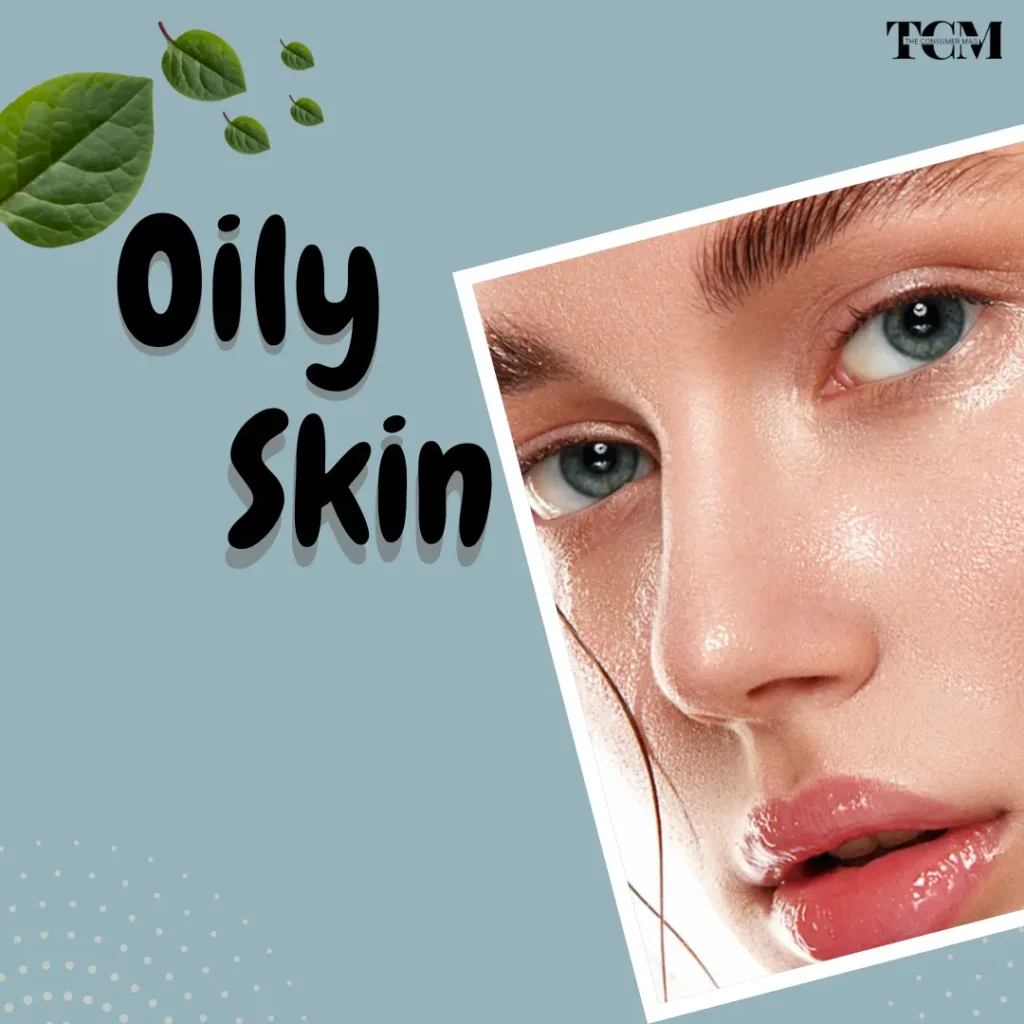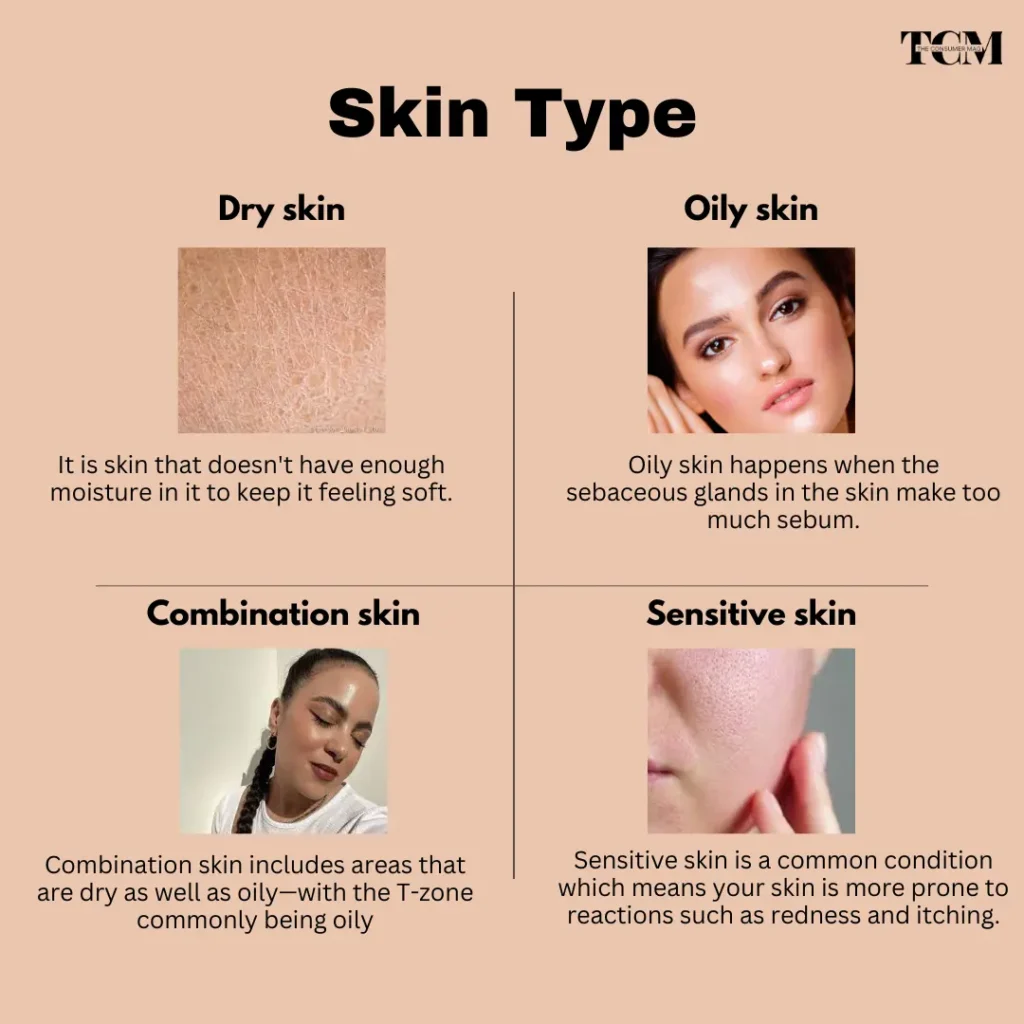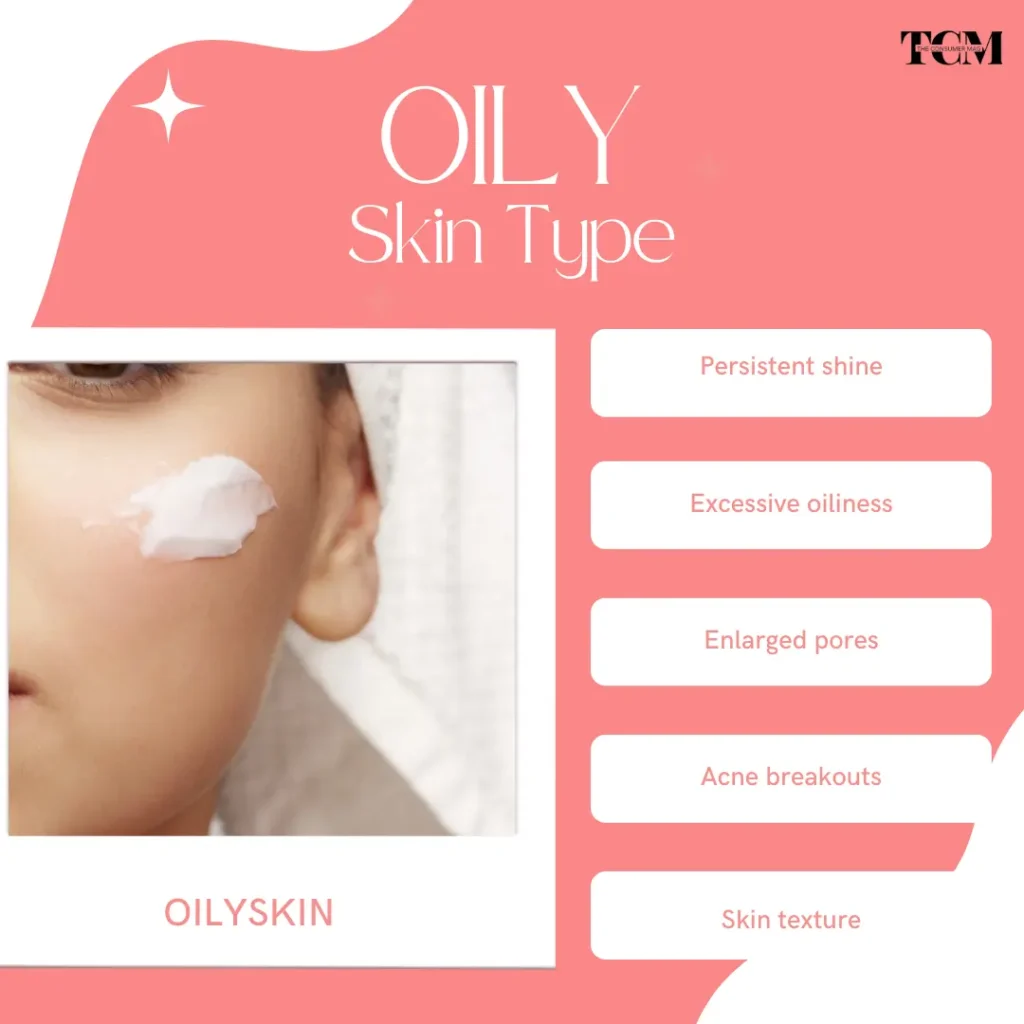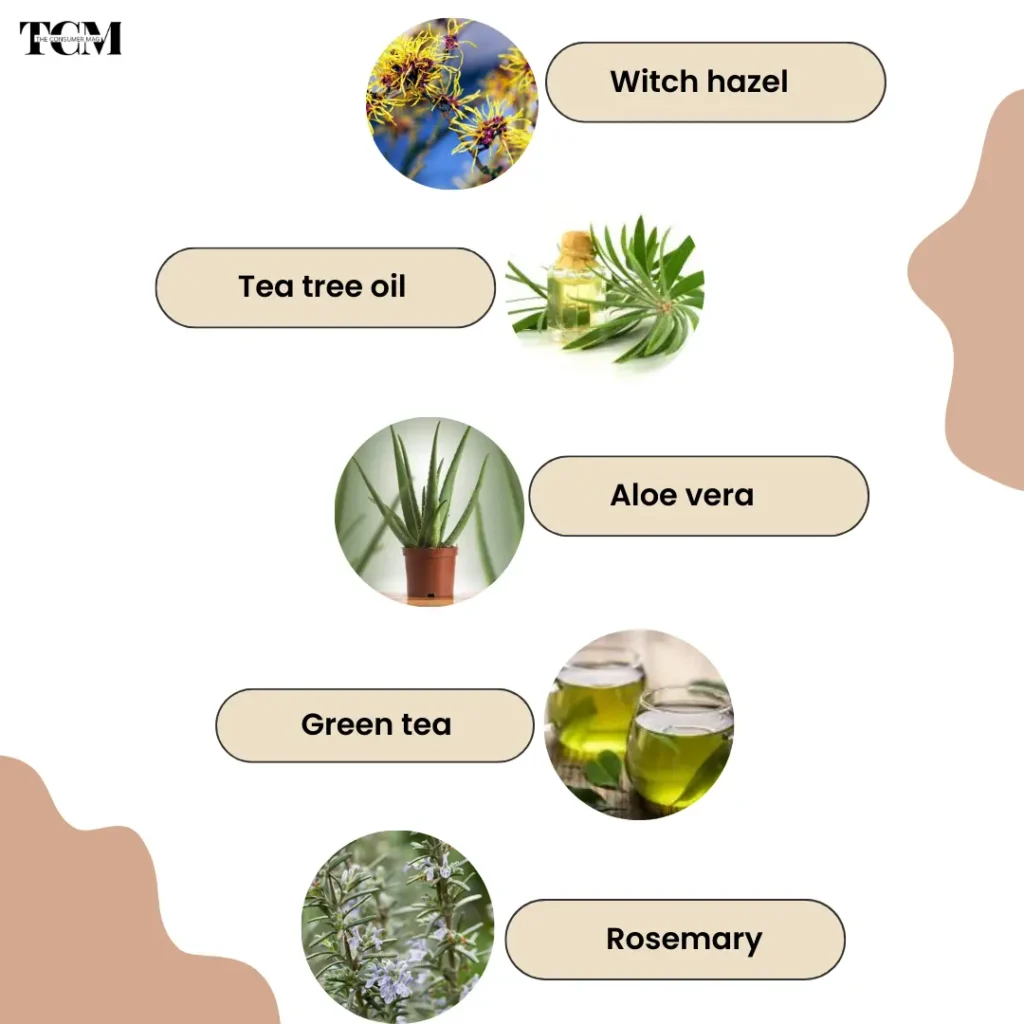Advertising Disclosure
Introduction

If you have acne-prone skin and have noticed that your makeup slips off faster than it should or that your skin glows and gleams for absolutely no reason,
Well, if you have ever experienced any of this, it means you have oily skin. Don’t worry; a hefty number of people in our population have oily skin.
In favorable times, it’s due to heredity, which means it has been passed on in your genes like a legacy.
But those tiny, unfavorable times with skin could be a reaction to something or the result of your intake of excess oily food.
The purpose of this blog is to provide information about everything related to oily skin like Types, Symptoms, And Causes
Before we get into more in-depth information about oily skin, let’s first understand the variety of skin types.
Types of Skin: What are the Four Types of Skin?

There are five types of skin: dry, oily, combination, normal, and sensitive.
Dry skin: When you feel and see cracks, flakiness, and stretchiness on your skin, you have dry skin.
Oily skin: If you feel a layer on your skin and when you touch it, you have a slippery-oily substance on your fingers, If you can see a gleaming, glowy look on your face even though you have not applied any products,
Combination skin: From the region around your brows down a perpendicular line crossing the bow of your lips to the chin, including your nose, is called the T-Area.
When the T-area of your skin has an oily layer to it but the rest of your face feels stretchy and dry, this means you have combination skin.
Sensitive skin: When there is a constant fluctuating irritation on your skin, like itching, burning, etc., you have sensitive skin.
How to Know What Skin Type You Have
Understanding your skin type is easier than you would think. It takes less than a minute to follow the process, and you will get the results in the next 30 minutes.
- Wash your face with tap water and a cleanser, and towel dry it.
- Let it be for 30 minutes.
- After 30 minutes, analyze how you feel on your skin and cross-check with the list given above to know where you fall.
Three steps, and you already know what your skin type is! easy right?
Oily skin type

Skin requires a certain amount of oil to be hydrated and moisturized, and to fulfill that need, the sebaceous glands located within our skin release an oily substance called sebum.
When this sebum is released, it protects the skin from getting dry and against wrinkles. It also gives a shine to your skin and keeps it moisturized.
But when released in excess, this skin lubricant clogs pores and enlarges them. It also causes blackheads, acne, and an increased accumulation of dead skin cells.
You all must have searched. How to get rid of oily skin has been searched various times on your search engine just to find a cure, and most of you must have even come across one.
But getting rid of oily skin is a wish you wouldn’t want to be granted. It is beneficial to you, but it is damaging. What you truly need is to control the excess release of oil instead of completely wiping it out.
Jumping from one issue to another will only cause hassle and provide no satisfaction.
When you get rid of its characteristics completely, you will be welcomed with dry skin, which is another issue your skin does not need.
Hence, controlling oil is the best solution you have to keep that natural moisture without blackheads, acne, or clogged pores.
Symptoms of Oily Skin
Some of the symptoms of oily skin are mentioned below; please have a look.
- Excessive oiliness: You would feel a sheen layer on your face. Especially the t-zone of your face would feel greasy.
- Enlarged pores: People with this have visibly larger pores due to excess sebum.
- Acne breakouts: Oily skin is acne-prone.
- Skin texture: Due to the accumulation of dead skin cells, you would feel a rough texture.
- Persistent shine: Oily skin has a continual glow due to the oily substance sebum.
Causes of Oily Skin
You must frequently ask yourself, “What causes oily skin? Well, there are a variety of reasons that can cause oily skin; the five most common causes are listed below for your information.
- Genetics: It is usually inherited through your genes. This means your parents must also have the same excess release of sebum and its issues as you.
- Hormonal changes: The hormonal fluctuations can also affect the sebaceous gland and compel it to release extra sebum. Especially during pregnancy.
- Medication side effects: Some of the medicines leave a side effect of oily skin as they affect the sebaceous gland during treatment.
- Environmental factors: Environmental factors like humidity or climate change can stimulate the gland and increase the release of sebum.
- Skincare products and habits: Using products that do not suit your skin can trigger your glands to turn your dry or normal skin into an oily one. Products like harsh cleansers or those made for dry skin. Your habits, like eating oily foods frequently, can also be a major cause.
Oily Skin: A Blessing and A Curse
As the heading suggests, oily skin is both a blessing and a curse, as it has its benefits as well as its drawbacks.
Here we will discuss some of the benefits and drawbacks of oily skin.
Benefits:
- Natural moisture: Sebum provides natural moisture to your skin and keeps it hydrated and healthy.
- Slower aging: Due to sebum, the dryness in the skin reduces. It also provides a layer of moisture on your skin, preventing wrinkles for as long as possible. Which directly leads to a slower appearance of aging.
- Sun protection: The layer of sebum over your skin provides a barrier between you and the sun’s rays. That leads to good protection against the sun.
- More resilient skin: Due to the layer, the skin is protected from the external environment and its impurities like dust, etc.
- Retains moisture in harsh environments: Especially in the extreme winter season when the skin cracks and dries. People with oily skin would not face as many problems as people with other skin types.
- Better appearance of makeup: Due to the oiliness of the skin, the makeup looks better on the skin than on those who have dry skin, as there is no flakiness or ashy appearance, and the beauty of the skin is enhanced.
Drawbacks:
- Acne breakouts: This skin clogs the pores, which makes it more susceptible to acne-related issues.
- Enlarged pores: It has visibly larger pores than normal due to excess oil clogging the pores.
- Skin shine: The constant shine due to the layer of sebum on your face can make you look greasy and lead to constant oil wiping off your skin.
- Makeup difficulties: Due to the sebum layer, the makeup is harder to stay fixed, and to keep it long-lasting a few extra sprays of setting spray are required.
- Skin texture issues: Oily skin leads to the accumulation of dead skin cells, which is hard to get rid of These formations cause skin texture issues.
Natural Elements To Cure Oily Skin

- Witch hazel: This natural astringent helps tighten skin and minimize pores while also reducing excess oil production.
- Tea tree oil: Tea tree oil has anti-bacterial properties and can control the breakout of acne on your skin. It can also control sebum production.
- Aloe vera: Aloe vera has anti-inflammatory and healing properties and can reduce irritation, acne, and even clear complexions.
- Green tea: Is rich in antioxidants and anti-inflammatory compounds that can help control oil production and protect the skin from damage caused by free radicals. This element is one of the best
- Rosemary: Rosemary extract has antimicrobial properties and can help control acne-causing bacteria. It also has a toning effect on the skin and helps reduce excess oiliness.
Elements to Avoid in Products
- Heavy Oils: Products that contain heavy oils like coconut oil, cocoa butter, etc. can increase oil problems on already excessively oily skin.
- Harsh Cleansers: Harsh cleaners can rid your skin of all-natural oil, which would signal your sebaceous glands to produce more oil.
- Synthetic Colorants: Artificial colorants and dyes have a completely different effect on your skin. Besides giving color to the product, it also causes irritation and damage.
- Heavy or Occlusive Ingredients: Ingredients like petrolatum or lanolin create a barrier between the trapped oil and the surface of your skin, which can lead to clogged pores.
- High-Glycemic Ingredients: High-glycemic foods, when consumed, can aggravate the production of oil on your skin. This is why it is said to avoid oily foods, sugar, and refined carbohydrates.
Elements to Look for in Products to Cure Oily Skin
- Salicylic Acid: Beta hydroxy acid (BHA), which is salicylic acid, helps penetrate the pores and exfoliates dead cells as well. They also help regulate the production of sebum and treat acne.
- Glycolic Acid: This is an alpha hydroxy acid (AHA) that helps exfoliate the skin and remove dead skin cells. It is also a major source of unclogging pores.
- Clay or activated charcoal: Clay or activated charcoal absorbs excess oil and impurities from the skin, which could lead to better and healthier skin.
- Niacinamide (Vitamin B3): Niacinamide helps regulate sebum production, reduces pore size, and has anti-inflammatory properties that can improve the overall health of the skin.
- Hyaluronic Acid: It is not common knowledge that oily skin itself still needs moisture and a source of hydration. Hyaluronic acid is a lightweight hydrating ingredient that can attract and retain moisture in the skin without adding extra oiliness.
Natural Facemasks to Cure Oily Skin at Home
It is important to take care of your skin and provide it with the same amount of rest and nutrients as you provide your body. Skin, being the most sensitive organ of all, requires a bit of extra pampering to keep it healthy and glowing. Avoiding impurities is a far-fetched shot that you cannot truly catch, but healing the ones already on your skin, well, that can be done.
Here is a small tip for skincare for oily skin at home, use this facemask once a week and notice the jaw-dropping change in just one use.
Ingredients:
- 1 tsp (teaspoon) of Bentonite clay
- 1 tsp of Apple cider vinegar
- 1 tsp of Honey (optional)
- 2-3 drops of Tea tree oil (optional)
- Water (as needed)
Instructions:
- Mix bentonite clay with apple cider vinegar and honey in a small bowl.
- Stir it well and add tea tree oil (optional)
- Add water to make a smooth paste—not too thin, not too thick.
- Apply it to your face and leave it to dry.
- Once it is dry, rinse your face and scrub the paste out.
- Tap dry with a towel.
Easy, isn’t it? See the results for yourself and repeat this facemask according to your skin’s requirements.
Conclusion
Here, we discussed oily skin, its causes, and how to treat it.
Now you know how to check if you have oily skin and what products to avoid when buying one.
If you have any questions that we may have missed answering, you can ask them in the comment section, and we will get in touch with you with accurate and uncommon knowledge that can help you live a better and healthier life.
